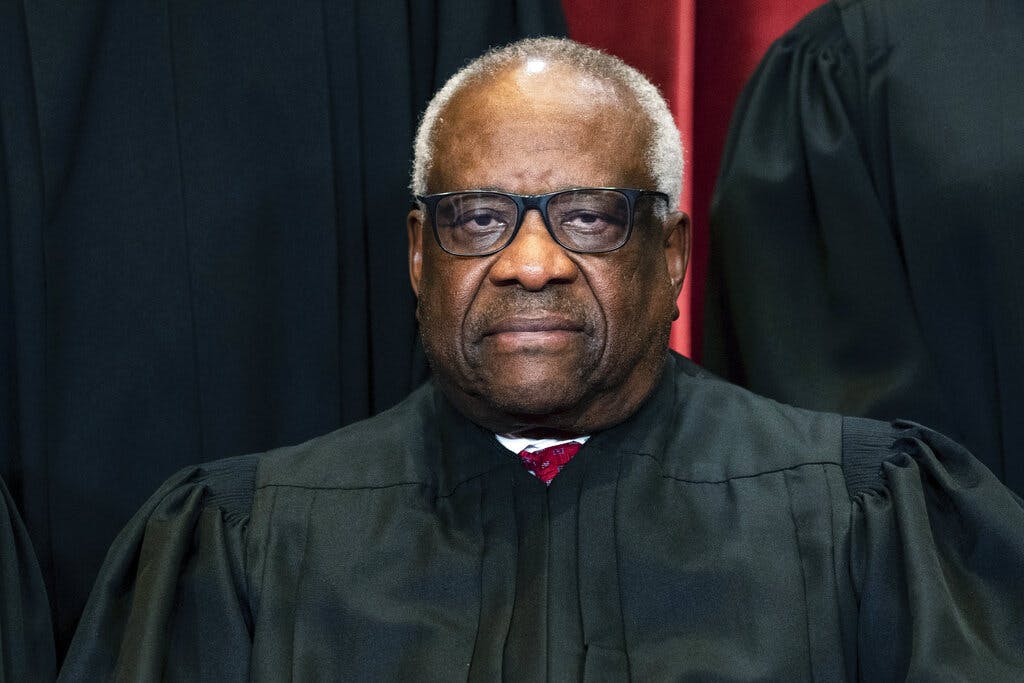Could Justice Clarence Thomas, Champion of a ‘Colorblind Constitution,’ One Day Undo the Legacy of Brown v. Board of Education?
It would not be the first time that the court’s senior justice has been alone in a dissent that doubles as prescience.

The Supreme Court’s decision, by a 6-to-3 margin, to allow South Carolina to keep in place a congressional map that a lower court ruled was unconstitutionally racially gerrymandered features a concurrence that could lead to the eventual dilution of one of the court’s most venerable precedents.
The decision in Alexander v. South Carolina State Conference of the NAACP was written by Justice Samuel Alito. It mandates that “a party challenging a map’s constitutionality must disentangle race and politics if it wishes to prove that the legislature was motivated by race.” It also ruled that courts are to evaluate maps with the “presumption that the legislature acted in good faith.”
A unanimous three-judge panel of the South Carolina district court had held that the map in question, which covers the territory to Charleston from Savannah and is spoken for in Congress by Representative Nancy Mace, had been so drawn as to amount to a “bleaching” out of Black voters. After the current map was drawn in the wake of the 2020 Census, the lower court found that the district lost 62 percent of its Black voters.
Justice Alito, though, reckons that the NAACP, which was challenging the map, “provided no direct evidence of a racial gerrymander and their circumstantial evidence is very weak.” That view is not shared by Justice Elena Kagan, who writes in dissent that “the majority goes seriously wrong” and that its “attempt to explain its contrary result fails at every turn.”
Looming over Alexander is a precedent from 2019, Rucho v. Common Cause. There the court, by a 5-to-4 margin, ruled that while partisan gerrymandering is “incompatible with democratic principles,” such allegations cannot be reviewed by courts because they are nonjusticiable political questions. Justice Kagan dissented then, too, writing that “of all times to abandon the Court’s duty to declare the law, this was not the one.”
The rule of Rucho, whose majority opinion was written by Chief Justice Roberts, means that excessive partisanship is not a valid basis for courts to nullify a congressional map. Instead, race must be the “predominant factor” in the drawing of a map. As race and partisan affiliation are frequently correlated, this has proved to be a high hurdle to clear, as Alexander demonstrates.
For the court’s senior justice, Clarence Thomas, the court’s gerrymandering jurisprudence has not gone far enough. He writes that “drawing political districts is a task for politicians, not federal judges. There are no judicially manageable standards for resolving claims about districting, and, regardless, the Constitution commits those issues exclusively to the political branches.”
Justice Thomas adds that a “colorblind Constitution does not require that racial considerations ‘predominate’ before subjecting them to scrutiny,” and that “racial gerrymandering claims to ask courts to reverse engineer the purposes behind a complex and often arbitrary legislative process.” He calls judicial intervention into the messy politics of electoral cartography a “fool’s errand.”
The justice takes a practical approach, writing, “When nearly all black voters support Democrats” — 90 percent of Black voters in South Carolina voted for President Biden in 2020 — “an effort to strategically sort Democratic voters can be indistinguishable from an effort to strategically sort black voters.” If politics and race cannot be disentangled, then neither can suffice as a reason for judges and justices to void maps drawn by lawmakers.
Justice Thomas, though, is hunting bigger constitutional game. He notes that the “view of equity” — meaning when a court can grant non-monetary remedies, like redrawing a map — “required to justify a judicial map drawing power emerged only in the 1950s.” The Supreme Court, in 1954, ruled in Brown v. Board of Education that separating schoolchildren on the basis of race was unconstitutional. Desegregation, though, was slow in coming.
That is why, Justice Thomas explains, in a followup case — known as Brown II — the high court “took a boundless view of equitable remedies” in order to reinforce desegregation. Justice Thomas describes that dispensation elsewhere as defined by “extravagant uses of judicial power … at odds with the history and tradition of the equity power and the Framers’ design.”
Justice Thomas fears that even Justice Alito does not go far enough in renouncing a role for the courts in keeping judges away from the political cartographers. That position is now a lonely one, as nary a justice joined him in suggesting that even a racially motivated map should be left untouched by the bench. If that view eventually gains traction, though, it would not be the first time Justice Thomas has proven farsighted.

